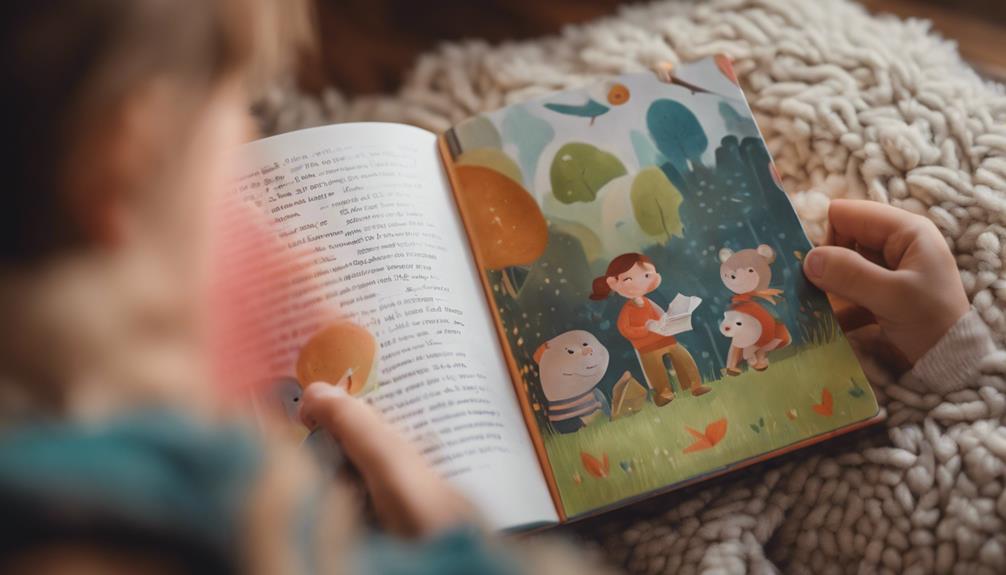To effectively engage your baby in reading, it is important to select age-appropriate books with interactive elements such as touch-and-feel for better participation. Use a calming tone to establish a peaceful environment and promote involvement by asking questions and involving them in turning pages. It is essential to focus on the durability and safety of books, incorporating reading into daily routines to strengthen your connection. Create a stimulating reading space with easily accessible books and a variety of textures. Pay attention to your baby’s reactions and ask simple questions to further engage them. By following these suggestions, you can significantly enhance your baby’s language, cognitive, and emotional development.
Key Takeaways
- Choose age-appropriate books with interactive elements.
- Use a soothing tone to create a calm reading environment.
- Encourage participation by pointing, asking questions, and allowing physical exploration.
- Prioritize book durability and safety with sturdy materials.
- Incorporate reading into daily routines to strengthen the parent-baby bond.
Benefits of Reading to Babies
Why is reading to your baby so important?
Reading to your baby plays an essential role in their language development. By exposing your baby to words early on, you're setting the foundation for a robust vocabulary. According to research, children who are read to as babies tend to have larger vocabularies by the age of 3, showcasing the long-term benefits of early reading.
Additionally, reading to your baby not only supports language development but also helps in building logical thinking, communication skills, emotional intelligence, and pre-literacy skills.
As your baby enjoys the company and sounds of reading, they explore books through senses like touching and mouthing, aiding in their overall cognitive development.
It's evident that the benefits of reading to your baby extend far beyond simply enjoying a story together; it lays the groundwork for their future academic success and overall well-being.
Choosing Age-Appropriate Books

When selecting books for your baby, consider their age and developmental stage to choose age-appropriate reading material that will engage and benefit them.
For babies under 6 months, opt for board books with high-contrast pictures to capture their attention.
Introduce touch-and-feel books with textures and flaps for babies aged 6-12 months, allowing them to explore through touch.
Toddlers aged 12-18 months benefit from books with simple sentences and clear images that they can easily understand.
As your toddler grows to 18-24 months, interactive books with familiar objects or animals can engage them actively in the reading process. These interactive books can help with their cognitive development and language skills.
Additionally, books with repetitive text and rhymes can aid toddlers in language development and memory retention.
Interactive Reading Techniques

When reading to your baby, engaging dialogues and interactive story exploration are key. Encourage your little one to touch, feel, and explore different elements in the book for a hands-on experience.
Point to pictures, ask questions, and wait for responses to promote interaction and language development.
Engaging Dialogues
Engaging in interactive reading with your baby involves asking questions and encouraging dialogue to enhance their learning experience. By fostering back-and-forth interactions during reading sessions, you can promote communication skills and cognitive development in your little one. Encouraging your baby to point to pictures or make sounds while reading can further enhance the interactive experience. Using engaging voices and facial expressions will captivate your baby's attention, making the reading session more enjoyable and beneficial.
Here is a table summarizing key points for engaging dialogues during interactive reading:
| Key Points | Description |
|---|---|
| Ask Questions | Encourage curiosity and critical thinking by posing questions about the story. |
| Encourage Dialogue | Promote communication skills by engaging in conversations during reading. |
| Back-and-Forth Interactions | Foster a dynamic exchange by responding to your baby's vocalizations. |
Interactive Story Exploration
To enhance your baby's interactive reading experience, incorporate interactive story exploration techniques that involve tactile elements and engaging activities in the books you choose to read together. Utilizing books with flaps, mirrors, textures, and sounds can captivate your baby's attention and make the reading session more interactive. Encourage your little one to touch, feel, and explore these elements as you go through the story.
Interactive reading techniques not only engage your baby but also help in developing sensory skills, hand-eye coordination, and cognitive abilities. By pointing to objects in the book, making sounds, and prompting your baby to interact with the story, you're fostering a more immersive reading experience.
Moreover, interactive story exploration plays a significant role in enhancing language development. It can spark a love for reading in your baby and strengthen the bond between caregiver and child.
Using a Soothing Tone

When reading to your baby, using a soothing tone can have significant benefits. A gentle voice can create a calming atmosphere, helping your baby relax and focus on the story.
Gentle Voice Benefits
Using a gentle voice while reading to your baby can create a calming and secure environment for them. This simple practice has numerous benefits that can positively impact your baby's development:
- Promotes Calmness: Babies are more likely to feel at ease and relaxed when read to in a soothing tone, aiding in their overall emotional well-being.
- Encourages Engagement: Reading with a gentle voice can capture your baby's attention and make the storytelling experience more interactive, enhancing their cognitive skills.
- Strengthens Bonding: A comforting voice during reading sessions helps babies associate warmth and security with books, strengthening the parent-child relationship.
Research supports the significance of using a gentle voice while reading aloud. According to a study published in the Journal of Developmental and Behavioral Pediatrics, 'Babies respond positively to a caregiver's gentle and comforting voice during reading sessions, which can foster a sense of safety and trust.'
Incorporating this simple technique into your reading routine can have lasting benefits for both you and your baby.
Calming Tone Importance
Using a gentle and soothing tone while reading to your baby can greatly enhance the overall reading experience and foster emotional connection. Infants respond well to a calming voice, which can increase their engagement during reading sessions.
By using a soothing tone, you can help regulate your baby's emotions and create a relaxed atmosphere, turning reading time into a pleasant and comforting activity. Your voice has the power to convey emotions, making your baby feel secure and connected as they listen to stories.
Research indicates that babies are more attentive and open to language when spoken to in a calm and soothing manner during reading. As a result, maintaining a soothing tone during reading sessions with your baby is essential for building a strong emotional bond and promoting a positive reading experience.
Encouraging Participation

To encourage your baby's participation during reading, engage them by pointing to pictures and repeating simple words. Asking questions during the reading session can also help keep your baby involved and promote interaction.
Additionally, using interactive books with features like flaps, textures, and mirrors can capture your baby's attention and make the reading experience more engaging for them. Remember to allow your baby to turn the pages and explore the book with their hands, as this physical interaction can further enhance their interest in the story.
Book Durability and Safety

When selecting books for your baby, prioritize durability and safety by opting for board books, cloth books, or vinyl books. These materials are sturdy and can withstand the wear and tear that comes with your baby's exploration. Look for books with rounded edges and sturdy pages to prevent injuries. Avoid books with small parts, sharp edges, or loose components that can be choking hazards. It's essential to choose books labeled as baby-proof or baby-safe for peace of mind.
Regularly inspect the books for wear and tear, discarding damaged ones to guarantee safety. According to child safety experts, 'It is important to check books for any signs of damage, such as torn pages or loose pieces, as these can pose serious risks to your baby.'
Incorporating Reading Into Routine

Consider making reading a daily habit in your baby's routine to foster a strong bond and enhance their language skills.
To incorporate reading into your baby's routine effectively, try the following:
- Hold Books: When reading to your baby, hold the books in a way that allows them to see the pictures clearly. This helps keep your baby engaged and focused on the story.
- Turn the Pages: As you read, involve your baby by allowing them to turn the pages. This simple interaction not only enhances their fine motor skills but also makes them feel active participants in the reading process.
- Baby Hears: Make sure that your baby hears your voice clearly while reading. This helps them associate the sound of your voice with comfort and storytelling, creating a positive reading experience.
Incorporating these practices into your daily routine can create a nurturing environment for reading to babies, fostering a love for books and language development.
Reading Environment Setup

Make sure that your home is set up to encourage and facilitate your baby's interaction with books by creating a stimulating reading environment.
Your baby loves exploring new things, so keep books easily accessible by placing them in toy baskets or on low shelves where they can reach and choose. Introduce books with different textures, flaps, and mirrors to engage your little one in interactive reading experiences that involve touching, seeing reflections, and making sounds.
Attend library story times to expose your baby to a variety of books and engage in group reading activities. Include familiar objects like stuffed animals or toys while reading to create a cozy and familiar atmosphere.
Engaging With Baby's Responses

Interact with your baby's responses during reading time by observing their cues and encouraging their exploration of books through touch and play. Your baby is a wonderful, curious little being who's keen to engage with the world around them, including the stories you share.
Here are some ways to enhance your reading experience with your baby:
- Pay attention to cues: Notice when your baby displays excitement cues like calming down, widening eyes, or smiling while you read. Responding to these cues can make the reading experience more enjoyable for both of you.
- Encourage exploration: Babies often explore books by grabbing, mouthing, and chewing them. This tactile exploration is a normal part of their sensory development, so allow them to interact with the books in their own way.
- Ask questions: As your baby grows, encourage them to engage more by asking simple questions like 'What do you see?' or 'Can you point to the bunny?' This helps them develop thinking and language skills.
Engaging with your baby's responses during reading time can create a positive and enriching experience for both of you.
Frequently Asked Questions
How Should You Read to Your Baby?
When reading to your baby, vary your voice and engage with the content. Choose age-appropriate books with clear pictures and simple text. Ask questions, point to pictures, and use board books for easy handling.
What Is the Hardest Month of the Baby's First Year?
The hardest month of your baby's first year is often the fourth month with sleep regression, increased fussiness, separation anxiety, and growth spurts. Night wakings can be frequent, and changes in feeding patterns may occur.
What Advice Would You Give to the Parents of a New Baby?
For new parents, prioritize bonding and communication with your baby by starting early with reading. Choose engaging books, make it a routine, use different voices, and create a cozy atmosphere. Enjoy the special moments together.
What Week Is Hardest With a Newborn?
The first week with a newborn can be the toughest. Sleep deprivation, adjusting to a new routine, and understanding your baby's needs can feel overwhelming. Remember, patience, support, and self-care are crucial during this challenging time.
Conclusion
To sum up, reading to your baby has numerous benefits and can greatly aid in their cognitive development. By choosing age-appropriate books, using interactive techniques, and creating a soothing reading environment, you can foster a love for reading in your child from an early age.
Remember, 'you can't judge a book by its cover,' so take the time to read to your baby regularly and watch as they grow and learn through the power of storytelling.










